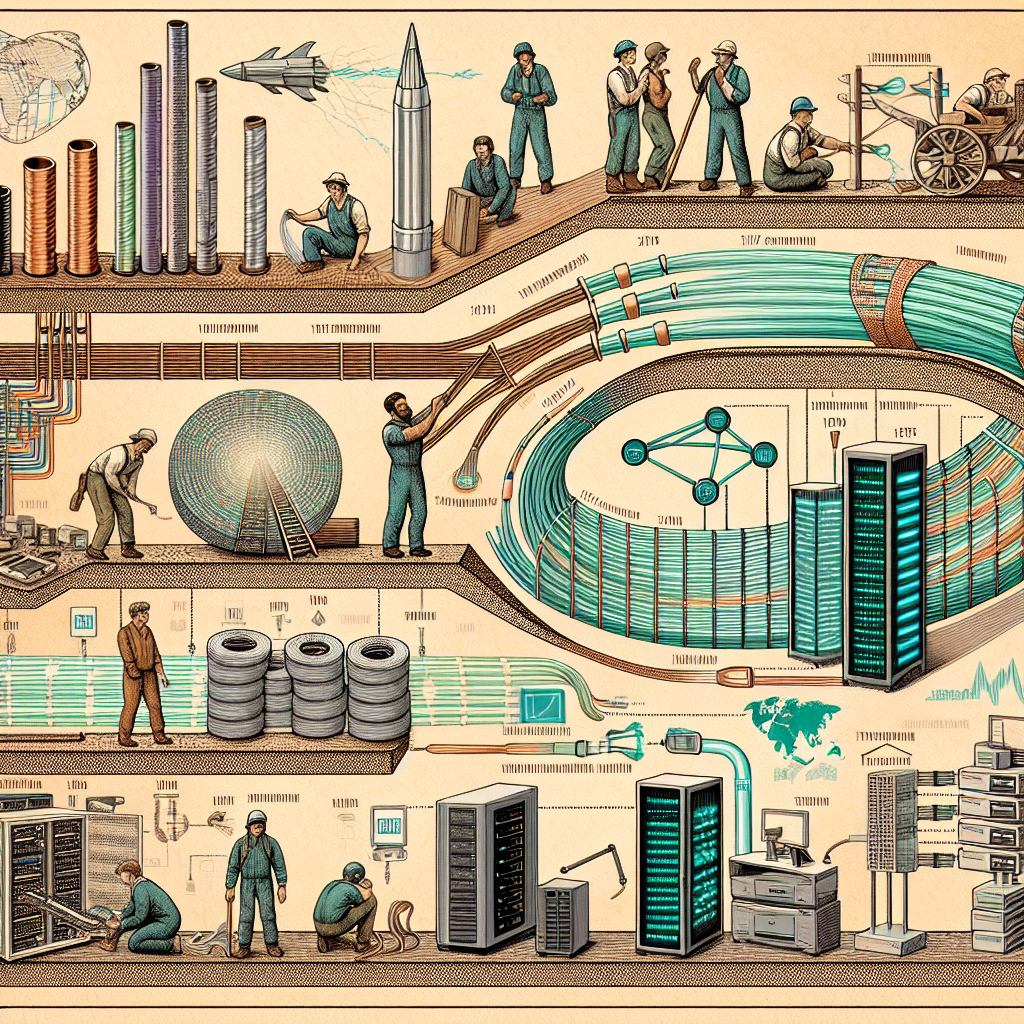Fiber optic network infrastructure development has revolutionized the way we communicate and interact in the modern world. This in-depth analysis explores the evolution of fiber optic technology, from its inception to the cutting-edge advancements of today. We delve into the intricate network of cables, routers, and transmitters that form the backbone of our digital connectivity, highlighting the key milestones and breakthroughs that have propelled this technology forward. By examining the growth and impact of fiber optic networks, we gain a deeper understanding of their crucial role in shaping our interconnected society. Explore the past, present, and future of fiber optic network infrastructure development in this comprehensive analysis.
The Significance of Fiber Optic Network Infrastructure Development
- Advantages of Fiber Optic Networks
Fiber optic networks offer numerous advantages over traditional copper-wire networks. The use of glass or plastic fibers allows for significantly higher bandwidth capacity, enabling faster data transmission speeds and greater reliability. Additionally, fiber optic cables are immune to electromagnetic interference, making them more secure for transmitting sensitive data. The durability of fiber optic cables also ensures a longer lifespan compared to copper cables, reducing maintenance costs and network downtime.
- Role in Enhancing Internet Connectivity
The development of fiber optic network infrastructure plays a crucial role in enhancing internet connectivity on both a local and global scale. By deploying fiber optic cables, internet service providers can deliver high-speed internet access to residential, commercial, and industrial users. This improved connectivity supports the increasing demands for bandwidth-intensive applications such as video streaming, cloud computing, and online gaming. Furthermore, fiber optic networks enable seamless connectivity for Internet of Things (IoT) devices, facilitating the growth of smart cities and the advancement of digital technologies.
- Impact on Data Transmission Speeds
Fiber optic network infrastructure development has revolutionized data transmission speeds, offering unparalleled performance compared to traditional copper-based networks. With the ability to carry data over long distances without signal degradation, fiber optic cables support Gigabit and even Terabit data rates, enabling rapid transfer of large volumes of data. This high-speed connectivity is essential for businesses, educational institutions, healthcare facilities, and government agencies that rely on real-time data exchange and high-definition video conferencing. Moreover, the low latency of fiber optic networks enhances the user experience for online activities, ensuring smooth and responsive communication and collaboration.
Understanding the Basics of Fiber Optic Technology
Significance of Fiber Optic Network Infrastructure Development
How Fiber Optic Cables Transmit Data
Fiber optic cables transmit data using pulses of light that travel along a glass or plastic core. This core is surrounded by a cladding layer that reflects the light inward, allowing it to travel long distances without significant loss of signal strength. The light signals are encoded with data and can travel at incredibly high speeds, making fiber optics an efficient and reliable means of communication.
Differences Between Fiber Optics and Traditional Copper Wiring
One of the primary differences between fiber optics and traditional copper wiring is the medium through which data is transmitted. Copper wiring relies on electrical signals to carry information, which can be susceptible to electromagnetic interference and signal degradation over long distances. In contrast, fiber optic cables use light signals that are immune to such interference, allowing for faster and more reliable data transmission.
Importance of Fiber Optic Network Components
Fiber optic network components play a crucial role in ensuring the efficiency and reliability of fiber optic communications. Components such as transmitters, receivers, amplifiers, and multiplexers help to encode, amplify, and route the light signals through the network. Additionally, connectors, couplers, and splices are essential for joining and maintaining the integrity of the fiber optic cables, ensuring seamless connectivity and optimal performance.
Historical Perspective on Fiber Optic Network Infrastructure

Milestones in the development of fiber optics
-
Invention of Fiber Optics: The concept of transmitting light through thin fibers was first theorized by Daniel Colladon and Jacques Babinet in the 1840s. However, it wasn’t until the 1960s that researchers like Charles Kao and George Hockham laid the groundwork for modern fiber optic communication.
-
First Fiber Optic Transmission: The first successful demonstration of transmitting light through a fiber optic cable occurred in 1970 by Corning Glass Works. This marked a significant milestone in the development of fiber optics for telecommunications.
-
Commercial Deployment: Throughout the 1980s, telecommunications companies started deploying fiber optic networks for long-distance communication, replacing traditional copper cables due to their higher bandwidth and reliability.
Evolution of fiber optic network architecture
-
Early Systems: Initially, fiber optic networks were point-to-point connections, limiting their scalability and efficiency. However, advancements in optical technology led to the development of multiplexing techniques such as wavelength division multiplexing (WDM) and time division multiplexing (TDM), enabling multiple signals to be transmitted over a single fiber.
-
Introduction of Fiber Optic Cables: The evolution of fiber optic cables from single-mode to multi-mode fibers allowed for improved transmission speeds and longer distances. This innovation revolutionized the telecommunications industry by enabling high-speed data transfer and internet connectivity.
-
Integration of Optical Amplifiers: The integration of optical amplifiers in the 1990s eliminated the need for frequent signal regeneration, enhancing the efficiency and reach of fiber optic networks. This advancement played a crucial role in expanding the global reach of high-speed internet connections.
Contributions to the advancement of telecommunications
-
Bandwidth Expansion: Fiber optic networks have significantly contributed to the expansion of bandwidth capacity, facilitating the transmission of large amounts of data at high speeds. This has been instrumental in supporting the growing demands of modern telecommunications services such as video streaming, cloud computing, and IoT applications.
-
Global Connectivity: The development of fiber optic network infrastructure has enabled seamless global connectivity, connecting regions worldwide and bridging communication gaps. This interconnected network has reshaped the way people communicate, conduct business, and access information on a global scale.
Key Innovations Driving Fiber Optic Network Growth
- Development of higher capacity fibers
The evolution of fiber optic network infrastructure has been significantly influenced by the continuous development of higher capacity fibers. Initially, traditional single-mode fibers were limited in terms of data transmission capacity. However, with advancements in materials science and manufacturing processes, new types of fibers with increased bandwidth capabilities have been introduced. These high-capacity fibers, such as multi-mode fibers and dispersion-shifted fibers, have revolutionized the data transmission capabilities of fiber optic networks, enabling them to support higher data rates and deliver enhanced performance.
- Implementation of dense wavelength division multiplexing (DWDM)
Another crucial innovation driving the growth of fiber optic networks is the implementation of dense wavelength division multiplexing (DWDM) technology. DWDM allows multiple data streams to be transmitted simultaneously over a single optical fiber by utilizing different wavelengths of light. This technology effectively increases the capacity of existing fiber optic infrastructure without the need for laying down additional physical cables. By enabling the efficient utilization of the available optical spectrum, DWDM has played a pivotal role in enhancing the scalability and efficiency of fiber optic networks, making them capable of supporting the ever-increasing demands for high-speed data transmission.
- Integration of fiber optic networks in various industries
The integration of fiber optic networks across diverse industries has also been a key driver in the growth and evolution of fiber optic network infrastructure. Industries such as telecommunications, healthcare, finance, and transportation have increasingly relied on fiber optic technology to meet their growing connectivity needs. The deployment of fiber optic networks in these sectors has not only facilitated faster and more reliable communications but has also paved the way for the development of innovative services and applications that leverage the high bandwidth and low latency characteristics of fiber optic connectivity. As industries continue to embrace digital transformation, the integration of fiber optic networks is expected to play a vital role in shaping the future landscape of connectivity and communication infrastructure.

Current Trends in Fiber Optic Network Infrastructure Development
In recent years, there has been a notable surge in the expansion of fiber optic networks, driven by the increasing demand for high-speed and reliable connectivity. This growth is particularly evident in urban areas where the need for efficient data transmission is paramount. Key trends shaping the current landscape of fiber optic network infrastructure development include:
-
Expansion of Fiber Optic Networks Across Geographical Regions: Fiber optic networks are being extended to cover more geographical regions, both in developed and developing countries. This expansion is fueled by the quest for enhanced connectivity and the growing reliance on digital technologies in various sectors including telecommunications, healthcare, finance, and education.
-
Adoption of Fiber-to-the-Home (FTTH) Technology: The adoption of FTTH technology is gaining momentum as more consumers seek faster internet speeds and higher bandwidth capacities. FTTH enables direct fiber connectivity to residential homes, offering unparalleled network performance compared to traditional copper-based systems. Service providers are increasingly investing in FTTH infrastructure to meet the escalating demands for high-speed internet access.
-
Challenges in Deploying Fiber Optic Infrastructure: Despite the advancements in fiber optic technology, deploying fiber optic infrastructure poses several challenges. One of the primary obstacles is the high initial investment required for laying fiber optic cables, especially in remote or rugged terrains. Additionally, obtaining regulatory approvals, navigating right-of-way issues, and ensuring network security are among the complex challenges that network operators face during the deployment phase. Overcoming these hurdles demands strategic planning, collaboration with stakeholders, and adherence to industry standards to ensure the successful establishment of robust fiber optic networks.
Regulatory Framework and Policies Impacting Fiber Optic Network Expansion
Current Trends in Fiber Optic Network Infrastructure Development
The regulatory framework and policies surrounding fiber optic network expansion play a crucial role in shaping the development of such infrastructure. Governments worldwide have recognized the importance of robust fiber optic networks for promoting economic growth, innovation, and digital connectivity. However, navigating the regulatory landscape can pose significant challenges for network operators and stakeholders.
-
Government Initiatives to Promote Fiber Optic Infrastructure:
Governments often implement various initiatives to incentivize the deployment of fiber optic networks. These can include funding programs, tax incentives, and streamlined permitting processes. By actively supporting the expansion of fiber optic infrastructure, governments aim to bridge the digital divide, enhance broadband access in underserved areas, and stimulate technological advancements. -
Regulatory Hurdles in Fiber Optic Network Deployment:
Despite the benefits of fiber optic networks, regulatory hurdles can impede their widespread deployment. Issues such as right-of-way regulations, permitting delays, and zoning restrictions can significantly delay network expansion projects. Additionally, concerns related to environmental impact assessments, property rights, and interconnection agreements can further complicate the regulatory landscape for fiber optic infrastructure development. -
Strategies to Overcome Regulatory Challenges:

To overcome regulatory challenges in fiber optic network deployment, stakeholders must engage proactively with regulatory bodies, policymakers, and local communities. Collaboration and transparent communication are essential for addressing regulatory concerns effectively. Moreover, adopting best practices in project management, conducting thorough feasibility studies, and leveraging technological advancements can help streamline the regulatory approval process and accelerate the deployment of fiber optic infrastructure.
Future Prospects of Fiber Optic Network Infrastructure
Emerging Technologies in Fiber Optic Communication
Fiber optic network infrastructure development is poised to witness a significant transformation with the emergence of cutting-edge technologies. One of the key advancements is the deployment of dense wavelength division multiplexing (DWDM) systems, allowing multiple signals to be transmitted simultaneously over a single fiber. This technology enhances the capacity and efficiency of fiber optic networks, enabling higher data transmission rates and improved network performance. Additionally, the integration of coherent optical communication technologies enables the transmission of data over longer distances with minimal signal degradation, further enhancing the reliability and reach of fiber optic networks.
Potential Applications of Fiber Optic Networks in the 5G Era
The rollout of 5G technology is set to revolutionize the telecommunications landscape, driving the demand for high-speed and low-latency connectivity. Fiber optic networks are poised to play a pivotal role in supporting the infrastructure requirements of 5G networks due to their unparalleled speed and bandwidth capabilities. With the deployment of fiber optic networks, telecommunications providers can ensure seamless connectivity for a myriad of applications, including autonomous vehicles, smart cities, and augmented reality. The low latency offered by fiber optic networks is crucial for enabling real-time communication and data transfer, making them an ideal choice for supporting the diverse requirements of 5G applications.
Sustainability Aspects of Fiber Optic Infrastructure Development
As the demand for high-speed internet connectivity continues to surge, the environmental impact of network infrastructure development has come under scrutiny. Fiber optic networks present a compelling solution to address sustainability concerns in the telecommunications sector. Compared to traditional copper-based networks, fiber optic infrastructure offers significant energy savings and reduced carbon footprint. The deployment of fiber optic networks requires less energy for data transmission and maintenance, making them a more environmentally friendly option. Furthermore, the longevity of fiber optic cables and their minimal need for replacement contribute to the overall sustainability of network infrastructure development. By embracing fiber optic technology, stakeholders in the telecommunications industry can not only meet the growing demand for high-speed connectivity but also contribute to environmental conservation efforts.
FAQs for Exploring the Evolution of Fiber Optic Network Infrastructure Development: A Comprehensive Analysis
What is fiber optic network infrastructure development?
Fiber optic network infrastructure development refers to the process of expanding and improving the network of fiber optic cables that allow for high-speed internet and telecommunications services. This involves laying down new fiber optic cables, upgrading existing ones, and building the necessary infrastructure to support the network.
Why is fiber optic network infrastructure development important?
Fiber optic network infrastructure development is crucial for meeting the growing demand for high-speed internet and reliable telecommunications services. Fiber optic cables can transmit data at much faster speeds and over longer distances compared to traditional copper cables, making them essential for supporting modern communication needs.
What are the key trends in fiber optic network infrastructure development?
Some key trends in fiber optic network infrastructure development include the deployment of fiber-to-the-home (FTTH) networks, the adoption of technologies like 5G and Internet of Things (IoT) which require high-bandwidth connections, and the growing importance of network security and reliability.
How does fiber optic network infrastructure development impact businesses and consumers?
For businesses, fiber optic network infrastructure development can improve productivity and efficiency by providing faster and more reliable internet connections. It also opens up opportunities for innovative services and applications. For consumers, it means faster internet speeds, better quality video streaming, and more reliable communication services.
What challenges are associated with fiber optic network infrastructure development?
Challenges in fiber optic network infrastructure development include the high cost of laying down fiber optic cables, the need for skilled labor to install and maintain the network, regulatory hurdles, and the logistical challenges of deploying infrastructure in urban areas with existing infrastructure.
How can countries accelerate fiber optic network infrastructure development?
Countries can accelerate fiber optic network infrastructure development by investing in public-private partnerships, providing incentives for network providers to expand their networks, streamlining regulatory processes, and promoting competition in the telecommunications industry. Education and training programs can also help develop a skilled workforce to support the growth of fiber optic networks.
